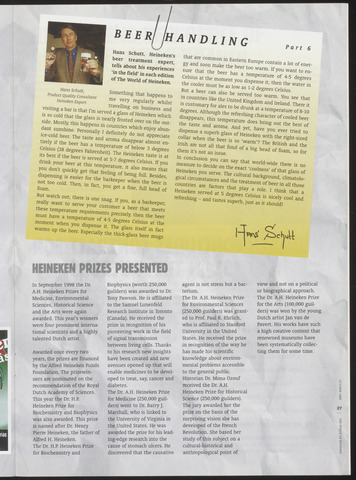HEINEKEN PRIZES PRESENTED
BEERI IHANDLING
Hans Schutt,
Product Quality Consultant
Heineken Export
Hans schutt, Heineken's
eer treatment expert,
tells about his experiences
'in the field'in each edition
of The World of Heineken.
Part 6
Something that happens to
me very regularly whilst
travelling on business and
visiting a bar is that I'm served a glass of Heineken which
is so cold that the glass is nearly frosted over on the out
side. Mostly, this happens in countries which enjoy abun
dant sunshine. Personally I definitely do not appreciate
ice-cold beer. The taste and aroma disappear almost en
tirely if the beer has a temperature of below 3 degrees
Celsius (38 degrees Fahrenheit). The Heineken taste is at
its best if the beer is served at 5-7 degrees Celsius. If you
drink your beer at this temperature, it also means that
you don't quickly get that feeling of being full. Besides,
dispensing is easier for the barkeeper when the beer is
not too cold. Then, in fact, you get a fine, full head of
foam.
But watch out; there is one snag. If you, as a barkeeper,
really want to serve your customer a beer that meets
these temperature requirements precisely, then the beer
must have a temperature of 4-5 degrees Celsius at the
moment when you dispense it. The glass itself in fact
warms up the beer. Especially the thick-glass beer mugs
that are common in Eastern Europe contain a lot of ener
gy and soon make the beer too warm. If you want to en
sure that the beer has a temperature of 4-5 degrees
Celsius at the moment you dispense it, then the water in
the cooler must be as low as 1-2 degrees Celsius.
But a beer can also be served too warm. You see that
in countries like the United Kingdom and Ireland. There it
is customary for ales to be drunk at a temperature of 8-10
degrees. Although the refreshing character of cooled beer
disappears, this temperature does bring out the best of
the taste and aroma. And yet, have you ever tried to
dispense a superb glass of Heineken with the right-sized
collar when the beer is so 'warm'? The British and the
Irish are not all that fond of a big head of foam, so for
them it's not an issue.
In conclusion you can say that world-wide there is no
measure to decide on the exact 'coolness' of that glass of
Heineken you serve. The cultural background, climatolo-
gical circumstances and the treatment of beer in all those
countries are factors that play a role. I think that a
Heineken served at 5 degrees Celsius is nicely cool and
refreshing - and tastes superb, just as it should!
In September 1998 the Dr.
A.H. Heineken Prizes for
Medicine, Environmental
Sciences, Historical Science
and the Arts were again
awarded. This year's winners
were four prominent interna
tional scientists and a highly
talented Dutch artist.
Awarded once every two
years, the prizes are financed
by the Alfred Heineken Funds
Foundation. The prizewin
ners are nominated on the
recommendation of the Royal
Dutch Academy of Sciences.
This year the Dr. H.P.
Heineken Prize for
Biochemistry and Biophysics
was also awarded. This prize
is named after Dr. Henry
Pierre Heineken, the father of
Alfred H. Heineken.
The Dr. H.P. Heineken Prize
for Biochemistry and
Biophysics (worth 250,000
guilders) was awarded to Dr.
Tony Pawson. He is affiliated
to the Samuel Lunenfeld
Research Institute in Toronto
(Canada). He received the
prize in recognition of his
pioneering work in the field
of signal transmission
between living cells. Thanks
to his research new insights
have been created and new
avenues opened up that will
enable medicines to be devel
oped to treat, say, cancer and
diabetes.
The Dr. A.H. Heineken Prize
for Medicine (250,000 guil
ders) went to Dr. Barry J.
Marshall, who is linked to
the University of Virginia in
the United States. He was
awarded the prize for his lead
ing-edge research into the
cause of stomach ulcers. He
discovered that the causative
agent is not stress but a bac
terium.
The Dr. A.H. Heineken Prize
for Environmental Sciences
(250,000 guilders) was grant
ed to Prof. Paul R. Ehrlich,
who is affiliated to Stanford
University in the United
States. He received the prize
in recognition of the way he
has made his scientific
knowledge about environ
mental problems accessible
to the general public.
Historian Dr. Mona Ozouf
received the Dr. A.H.
Heineken Prize for Historical
Science (250,000 guilders).
The jury awarded her the
prize on the basis of the
surprising vision she has
developed of the French
Revolution. She based her
study of this subject on a
cultural-historical and
anthropological point of
view and not on a political
or biographical approach.
The Dr. A.H. Heineken Prize
for the Arts (100,000 guil
ders) was won by the young
Dutch artist Jan van de
Pavert. His works have such
a high creative content that
renowned museums have
been systematically collec
ting them for some time.
27

